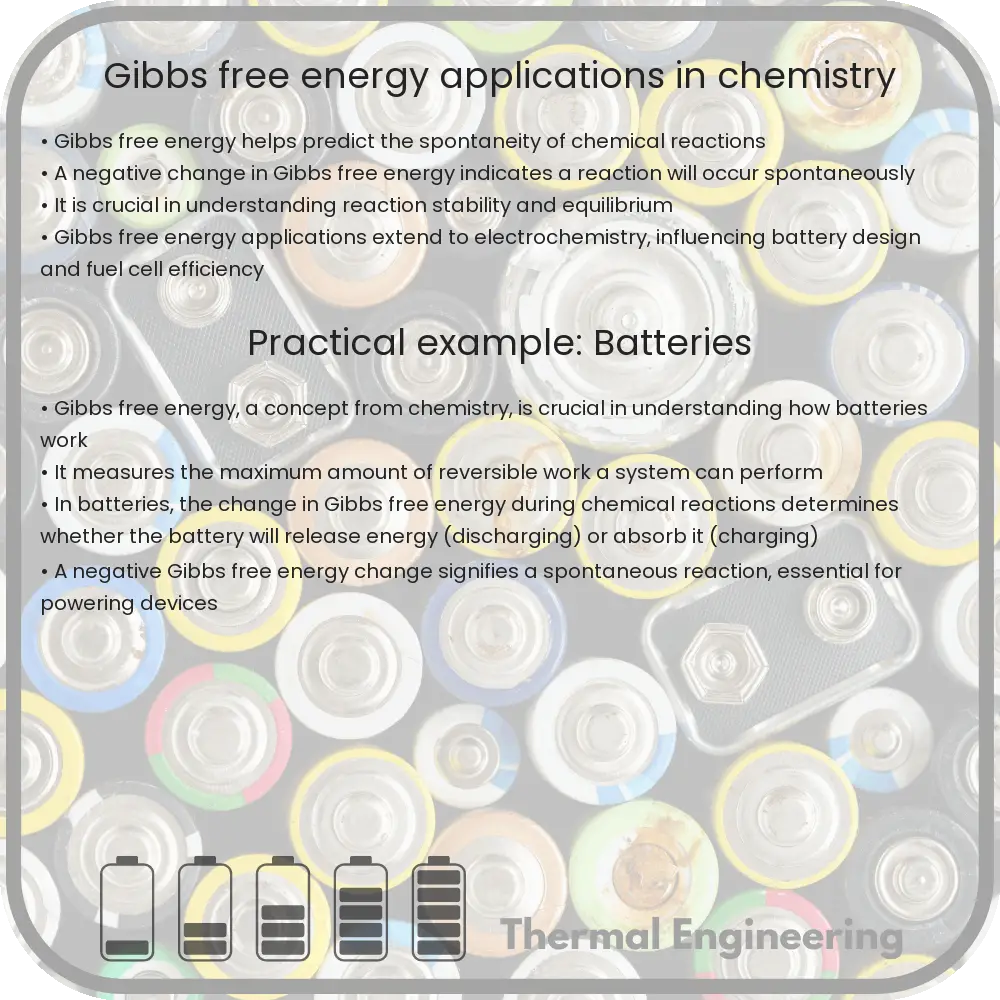Gibbs free energy, denoted as G, is a thermodynamic function used to predict the spontaneity of chemical reactions under constant temperature and pressure.

Understanding Gibbs Free Energy in Chemistry
Gibbs free energy, often symbolized as \( G \), is a thermodynamic quantity that is tremendously useful in chemical thermodynamics for predicting the feasibility of chemical reactions. It helps chemists understand whether a process or reaction will occur spontaneously under constant pressure and temperature.
What is Gibbs Free Energy?
The Gibbs free energy is named after Josiah Willard Gibbs, who introduced it in the 1870s. It combines the concepts of enthalpy (H), temperature (T), and entropy (S) into a single value and is given by the following equation:
\[ G = H – T*S \]
Where:
- H stands for enthalpy,
- T is the temperature in Kelvin,
- S represents entropy.
The significance of \( G \) lies in its ability to predict the spontaneity of a reaction. A negative change in Gibbs free energy (\( \Delta G < 0 \)) indicates a spontaneous reaction, whereas a positive change (\( \Delta G > 0 \)) suggests a non-spontaneous reaction.
Applications of Gibbs Free Energy in Chemistry
The concept of Gibbs free energy finds numerous applications in the field of chemistry:
- Predicting Reaction Spontaneity: As mentioned, the sign of \( \Delta G \) allows chemists to understand if a chemical reaction will occur spontaneously. This is crucial not only in academic research but also in industrial applications where predictability of reactions is necessary.
- Chemical Equilibrium: Gibbs free energy is directly related to the equilibrium constant of a reaction, given by the relationship:
\[ \Delta G = -RT \ln K \]
Where \( R \) is the universal gas constant, \( T \) is the temperature, and \( K \) is the equilibrium constant. This relationship helps in calculating the position of equilibrium in a chemical reaction.
- Thermodynamic Efficiency: In processes such as electrochemistry and metabolic pathways, the understanding of Gibbs free energy helps in assessing the energy efficiency. Changes in Gibbs energy indicate how much of the energy released in chemical reactions is available for doing useful work versus lost as heat.
- Phase Transitions: Gibbs free energy plays a crucial role in understanding phase transitions such as melting, vaporization, and sublimation. The conditions under which these transitions occur can be predicted by analyzing Gibbs energy changes.
- Environmental Chemistry: Calculations of Gibbs free energy assist in assessing the spontaneity and equilibrium of reactions involved in environmental processes. This can include interactions like the dissolution of pollutants in water or the decomposition of organic materials.
Conclusion
Gibbs free energy is a fundamental concept in chemistry that helps scientists and engineers understand and predict the behavior of chemical systems under various conditions. By relating enthalpy, entropy, and temperature, Gibbs free energy provides a valuable tool for exploring the spontaneity and dynamics of chemical reactions and processes. Whether it’s designing a new battery, synthesizing a novel compound, or managing an environmental cleanup, mastery of Gibbs free energy calculations opens up a wealth of strategic approaches in both theoretical and applied chemistry.